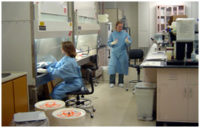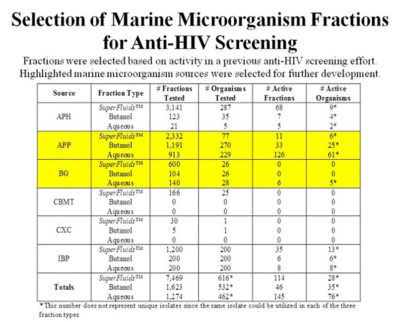APP-401, APP-069, and other anti-HIV leads isolated from screening over 10,000 marine microorganism fractions in cytoprotection and cytotoxicity assays
HIV – A Serious, Deadly Disease with Pandemic Potential
 Currently, there are about 40 million people living with HIV worldwide. In 2005 alone, 4.1 million became newly infected and 2.8 million died because of AIDS, and the overall number of people living with HIV has continued to increase with each successive year. There is no vaccine against HIV, and AIDS, if untreated, will lead to the death of over 95% of infected individuals 10 years post-infection.In the last few years, significant breakthroughs have been made in the field of AIDS treatment and anti-HIV therapy. However, these triple cocktail therapies have serious side effects and are financially unattainable by a majority of the HIV-infected population. In addition, resistant strains of HIV are emerging that contribute to the decline in the efficacy of these drug combinations.
Currently, there are about 40 million people living with HIV worldwide. In 2005 alone, 4.1 million became newly infected and 2.8 million died because of AIDS, and the overall number of people living with HIV has continued to increase with each successive year. There is no vaccine against HIV, and AIDS, if untreated, will lead to the death of over 95% of infected individuals 10 years post-infection.In the last few years, significant breakthroughs have been made in the field of AIDS treatment and anti-HIV therapy. However, these triple cocktail therapies have serious side effects and are financially unattainable by a majority of the HIV-infected population. In addition, resistant strains of HIV are emerging that contribute to the decline in the efficacy of these drug combinations.
Thus, new and cost-effective drugs, preferably directed at different viral proteins, need to be developed to keep ahead of this viral pandemic.
Nature as a Source of Novel Anti-HIV Drugs
Most of the anti-HIV drugs to date have been identified through rational drug design or screening of chemical compounds. More recently, attention has focused on screening natural resources or products for antiviral compounds, which should lead to a more diverse set of compounds with correspondingly more diverse activity. The marine environment represents an enormous and poorly explored resource for unique antiviral agents. This environment is a source of novel chemotypes and genetic entities with tremendous drug discovery potential. It is also extremely diversified due to the variety of marine habitats depending on numerous differences in natural salinities, temperatures, and pressures.
Marine Microorganisms for Ant-HIV Drug Discovery
 Aphios Corporation has established a library of over 1,500 diverse marine microorganisms and 20,000+ unique fractions of semi-purified marine molecules utilizing polarity-guided CXF fractionation technology. Our scientists and engineers are screening this unique library of diverse marine microorganisms – isolated from normal to extremophilic environments in United States territorial waters – and medicinal plants to discover novel anti-HIV drugs. Research is being done under Biohazard Safety Level-3 (BSL-3) conditions.
Aphios Corporation has established a library of over 1,500 diverse marine microorganisms and 20,000+ unique fractions of semi-purified marine molecules utilizing polarity-guided CXF fractionation technology. Our scientists and engineers are screening this unique library of diverse marine microorganisms – isolated from normal to extremophilic environments in United States territorial waters – and medicinal plants to discover novel anti-HIV drugs. Research is being done under Biohazard Safety Level-3 (BSL-3) conditions.
We screened 10,366 extracts from 578 marine microorganisms and identified 305 anti-HIV “hits” in preliminary cytotoxicity and cytoprotection anti-HIV assays. Subsequently, we selected 5 anti-HIV leads from secondary screens. These leads were determined to be highly or moderately active compared to the positive control 3TC (Lamivudine), with a measured EC50 of 0.165 µM. A closely related SuperFluids™ CXP platform can be utilized to manufacture drugs for preclinical development and commercial production.
Partnering Opportunity
 We are seeking a strategic partner to collaborate with in order to (1) isolate, purify, identify, characterize and structurally elucidate the bioactive compounds in five of the most anti-HIV active marine microorganisms; (2) evaluate in vitro mechanisms of action and any in vitro synergistic or additive effects with current antiretroviral therapies; and (3) evaluate the in vivo efficacy and toxicity of the purified anti-HIV compounds in a transgenic animal model. This research will be utilized to select a unique, lead anti-HIV candidate with a novel mechanism of action for clinical evaluation.
We are seeking a strategic partner to collaborate with in order to (1) isolate, purify, identify, characterize and structurally elucidate the bioactive compounds in five of the most anti-HIV active marine microorganisms; (2) evaluate in vitro mechanisms of action and any in vitro synergistic or additive effects with current antiretroviral therapies; and (3) evaluate the in vivo efficacy and toxicity of the purified anti-HIV compounds in a transgenic animal model. This research will be utilized to select a unique, lead anti-HIV candidate with a novel mechanism of action for clinical evaluation.
Subsequently, we plan to conduct IND-enabling preclinical studies of toxicity, pharmacology and efficacy studies, file an IND with the FDA and conduct clinical trials with a pharmaceutical partner